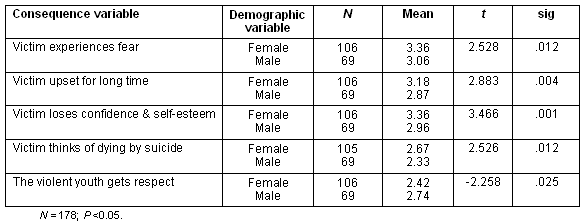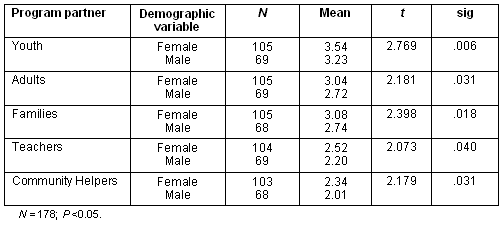Violence should not be ignored within the public health domain in Canada because the results of violence impact inter-related systems in all community settings1-3. In addition, violence can have long-term effects, and strategies are needed to limit its impact on people and their environments4-8. Violence is a common problem, but incidence can vary among different individuals and populations. Many people have preconceived ideas shaped by a mix of personal experience as well as media and other influences. A commonly held belief is that youth violence occurs principally in large urban centers, as opposed to rural and small towns (ie populations < 10 0009). A few studies set in the USA have examined violence within rural communities10-12. In these studies, the definitions of violence ranged from psychological non-physical behaviors, including taunting and teasing, to physical actions involving use of fists and weapons.
Other studies have focused on the predictors of violent behaviors for youth which include: familial violence, lack of parental warmth, lack of supervision and corporal punishment13-16; youth with a history of carrying weapons17; youth with poor interpersonal skills18; drug and alcohol use by students in elementary school19,20; and, a time of change in identity21.
The literature identifies youth violence as a significant problem and also the need to have a better understanding of youth violence in order to develop more effective anti-violence programs22. In a 2010 Statistics Canada report, reference is made to the increasing rate of violence for children and youth23. However, there is a lack of details that describe violence in rural Canadian communities, especially from the perspective of gender24-26. The current article is based on a multi-methods study that adds to the knowledge of violence by identifying possible gender differences among rural youth24-27.
This two-phase, mixed-method study generated information about the meaning of violence, its causes, consequences and possible solutions. The first phase, as reported elsewhere, included 52 qualitative interviews with youth in two different resource-based rural communities regarding their perspectives on violence25,27. The researchers in Phase 1 had no preconceived definitions of violence, rather the youth themselves would define violence and their perceptions would guide the development of the Phase 2 instrument used in the study reported here. Phase 1 qualitative interviews asked the youth (aged 11 to 18 years in grades 7 to 12) to respond to eight open-ended questions. The content included:
- the definition of violence
- is violence a problem?
- causes of violence
- types of violence
- personal experiences
- reasons to participate in violence
- community resources
- solutions to violence.
The development of the Phase 2 survey data collection instrument was guided by the thematic findings from the qualitative interviews. The use of the language of the youth from Phase 1 contributed to ensuring the questions for the survey were meaningful to the youth completing the survey questionnaire in Phase 228. The survey data, although not as in-depth as in the Phase 1 qualitative interviews, allowed for a larger sample of youth. The survey was pilot tested in one rural school in Southern Alberta, Canada, and refinements were made as necessary. The research team did not do psychometric testing on the instrument but future research should include this type of analysis.
The rural youth violence survey instrument was composed of demographic questions and 70 questions that specifically focused on violence. Using the qualitative findings, the survey questions were developed with anchoring from four-point Likert scales. Male and female youth answered questions on:
- the meaning of violence
- the causes of violence
- the consequences of violence
- solutions to violence within their respective rural communities.
The research received ethics approval for studies involving human subjects from the first author's university.
The youth chosen to participate were in grades 6 to 12, a group that previous research identified as having a rising incidence of violence on school grounds29. The researchers identified a number of rural middle and high schools and randomly chose three names.
Local school superintendents gave permission for the staff to be contacted by the researchers. In order to enlist the involvement of the schools, the research team gave a presentation at each site, detailing the goals, data collection methods and the process of obtaining consent. Information packages were then sent to the principals and consent forms were distributed to be signed by parents or guardians. In each of the schools the principal volunteered to be the site coordinator. This role involved the distribution and collection of consent forms and arranging for the in-classroom completion and collection of forms as well as liaising with the researchers. Students made the choice of whether or not to take the consent forms home for signature, allowing them to complete the survey questionnaire during regular class time. The signed consent forms were returned to the research site coordinator in the school and were kept in a secure and confidential location. Often, it took weeks for the forms to be returned to the school.
An ethical issue arose wherein it was important for students in the class to not be aware of who was participating in the survey. In the classroom, those students not participating in the research were given a handout on bullying with questions to complete by pencil at the same time other students were completing the survey. This potentially helped to ensure that students were not aware of who was participating.
The schools were located in Central Alberta and represented the different economic bases of natural resources and agriculture. Ultimately, only two of the chosen schools participated in the data collection phase. One school was situated in a natural resource community (with an economic base of oil and natural gas production) with an overall population of 5801, with 1400 persons in the 5 to 19 year age grouping. The other school was located in an agricultural setting (with an economic base of grain and cattle farming) of 671 people, with 190 persons in the 5 to 19 year age group30. The two rural communities chosen met the Statistics Canada definition for 'rural and small towns', whereby the population is less than 1000 persons who live beyond the main commuting zones of larger urban centers9.
The following presentation of descriptive data collected in 2006 from the quantitative phase of the study provides an overview of the perspective of rural youth based on gender and may be useful in the planning of future studies and the implications of accounting for gender differences when developing anti-violence programs.
Demographics
The entire demographic data profile showed that the total grades 6-12 population at the two schools was 259 students from which 178 students completed the survey, representing a response rate of 69%. Participants ranged in age from 12 to 20 years, with a mean of 16 years; 40% (n = 71) of the youth was male and 60% (n = 107) was female. Seventy-three percent (n = 129) of the respondent population lived with two parents; the highest percentage of respondents had one sibling (38%, n = 68). Sixty-four percent (n = 113) of the respondents had lived in the rural community from 11 to 20 years.
Meaning of violence
The youth were asked a number of questions related to their perceptions of what violence is as well as when and how it occurs. The four-point Likert scale ranged from 'strongly disagree' to 'strongly agree'. Females were more likely than males to view violence as the intent to harm someone (t = 2.45, p = .015) and the use of weapons was viewed as a form of bravado and toughness (t = 2.392, p = .018). Overall violence among youth was reported to be a normal occurrence in their lives (t = 2.08, p = .038). Although not statistically significant, males viewed violence as not having the primary purpose of inflicting harm. The carrying of weapons was for 'a show of toughness' and not to injure people. Items where males and females indicated no significant difference were: 'bullying gives power over others'; 'youth who are different are targets for bullying'; and 'violence serves as entertainment due to boredom in rural settings'.
Causes of violence
Both genders ranked their answers on the four-point scale from 'never', 'rarely', 'sometimes' to 'often' for 10 potential causes of violence. The items were: 'television and movie violence'; 'internet and video games'; 'violence in the home'; 'personal problems'; 'personal unhappiness'; 'peer pressure'; 'boredom'; 'alcohol and drugs'; 'competition between towns and schools'; 'getting even with others'; and, 'boyfriend/girlfriend issues'. The results showed that only 2 of the 10 causes were significant.
Females, more than males, believed that television and movies were factors in the creation of violence in their world (t = 3.384, p = .001), as well as video games and the internet as triggers for violence (t = 2.638, p = .009). Factors that were not viewed as causes of violence by both genders were interpersonal concerns such as unhappiness, individual problems and, surprisingly, alcohol and drugs. It appears that for this group of youth, the only difference between males and females was in perceiving technology as a trigger for violence.
Consequences of violence
The consequences of violence section of the survey questionnaire asked the youth to respond to 8 consequences of violence on a scale of 'never', 'rarely', 'sometimes' or 'often'. The items included: 'isolation'; 'fear'; 'feeling upset for periods of time'; 'loss of self-esteem'; 'loss of self-confidence'; 'development of physical problems (eg headaches)'; 'thoughts of suicide'; 'feelings of power;'and 'feelings of respect from peers'.
The results demonstrated that female youth were more aware than male youth of how victims of violence were personally and emotionally impacted by violence. In this study, females were more likely than males to agree that the victim experiences emotional reactions such as: fear, being upset, losing self-confidence, self-esteem and thoughts of suicide (Table 1). However, the males viewed violence as providing respect from their peers. Similar to the findings on the meaning of violence, the youth viewed violent acts as not being motivated by the need to have and/or demonstrate power.
Table 1: Consequences of violence (n = 178)

Solutions to violence
Youth were asked to rate 11 ideas for reducing violence on a four-point scale ranging from 'not at all useful' to 'very useful'. The ideas presented were: 'education for victims'; 'education for violent youth'; 'education for parents'; 'education for families'; 'education for school staff'; 'school rules against violence'; 'cameras inside schools'; 'supervision on school grounds'; 'security officers in schools'; 'sniffer dogs in schools'; and 'metal detectors in schools'.
Group differences were found in 6 of the possible 11 ideas for reducing violence (Table 2). Females were more likely than males to believe that parents and families need to receive education in order to reduce youth violence. Females were also more likely than males to accept more intrusive means to curb violence, including school initiatives such as zero tolerance against violence; supervision, both in schools and on school grounds; cameras or security officers in schools; sniffer dogs to find drugs; and, metal detectors for weapon identification. Males were not of the opinion that the solutions presented would be beneficial in preventing violence.
Table 2: Usefulness of solutions (n = 178)

Program partners
The final section asked the youth about the people they thought should be involved in the development of anti-violence programs. They ranked the 6 possible choices (youth, adults, families, teachers, community workers, and members of town council) on a scale of 'not at important', 'somewhat important', 'considerably important' or 'very important'. Once again, females were more likely than males to believe that youth themselves, adults, families, teachers and community helpers could make a difference in dealing with youth violence (Table 3).
Table 3: Possible anti-violence program partners (n = 178)

Discussion
Limitations
This research is limited by collecting data from only two rural schools. The third school had originally agreed to participate but when the data collection phase commenced, there was no assistance from this school. After two attempts to rectify the situation, data collection was abandoned at this site. It was not possible to recruit another school so late in the data collection phase. It is hoped that the survey will be replicated in a variety of schools. Increasing the number of school settings would allow for greater randomization and limit the impact of students to self-select, as was the case with the current study. A much larger sample would strengthen the generalizability of the findings. Another limitation is that the research did not examine how the growth and developmental stages of the youth could influence the data. Future research could examine how the differences in male and female maturational stages would impact on their perspectives of violence.
The results of this study indicate that violence exists among rural youth and causes them a great deal of concern. The study underscores the potential for distinct gender differences in relation to the meaning of violence, causes, consequences of violence for others and solutions. There is a need to incorporate the opinions of youth, especially females, in policy development and program planning.
Both genders indicated that violence in their lives was a normal occurrence. However, female respondents viewed the meaning of violence as the intent to harm but the carrying of weapons was believed to be for a show of bravado, as opposed to inflicting injuries on other youth. The notion that movies, television, internet and video games were triggers for violence was upheld more so by females than males. However, factors such as alcohol, drugs and interpersonal problems were not viewed by either gender as substantially contributing to violence among youth. This result is somewhat counter-intuitive because interpersonal issues could lead to self-medication possibly fuelling violent behaviors.
Males and females had quite different views of the consequences of violence. Males seemed to indicate that being involved in violent activities afforded them respect from their peers, possibly demonstrating a form of social status. Females, however, appeared to be more aware of and concerned about the emotional effects on victims, including suicide. A possible explanation for these differences in perception may lie with commonly held belief that females are socialized differently from males as they move through the life cycle. Such an assumption would require further study.
With regard to solutions to violence, female respondents were more likely than males to accept intrusive interventions that could interfere with their daily lives, such as increased security, supervision and tighter school rules. The proactive stance of females was also indicated in their belief that working with other youth, adults, families, teachers and community helpers could be useful in developing and implementing anti-violence strategies. The females seemed to believe that knowledge through education about violence begins in the home. Such an educative approach could begin early in a child's life and in the younger school grades as a way to prevent violence. This finding is similar to that of a recent study which recommended the need to involve parents as part of anti-violence programs for rural youth31.
The results of this study suggest that a 'one size fits all approach' may not be the most effective means for helping youth deal with violence, and for the promotion of violence prevention programs. For example, our study findings did not support the view that male youth carry weapons for the purpose of inflicting injury, as was reported from other research32,33. If the general belief of both genders that violence is normal in their lives was combined with the perceptions of the females, this might allow for the creation of anti-violence programs that have meaning for youth. For example, female youths' sensitivity to the impact of violence on others may provide an opportunity for dialogue among community leaders, decision-makers, and the youth. This form of prevention is necessary because previous studies have identified that if youth are exposed to violence over time it can have serious long-term effects24,32.
Policy-makers and clinicians need to be mindful that violence is a public health concern and assist in developing community-based solutions. Hence, from a public health planning perspective, youth who are concerned about violence provide healthcare professionals with a window of opportunity to dialogue with rural youth and mutually identify relevant anti-violence strategies. A top-down approach that imposes solutions can be viewed as an oppressive strategy that does little to empower youth as partners. This is especially important given the differing views on violence from the gender perspective. Mutual respect and understanding can lead to productive exchanges that result in meaningful anti-violence programs.
Acknowledgements
The authors acknowledge the funding provided by the Alberta Heritage Foundation for Medical Research. A special thank-you to school staff and especially the students who shared their ideas and perspectives.
References
1. Public Health Agency of Canada. National clearing house of family violence. Youth Violence Fact Sheet 2005. Ottawa, ON: Public Health Agency of Canada, 2005.
2. Shepherd J, Reardon D, Davis P, Vimpani G. Violence as a public health problem. BMJ 2003; 326(7380): 104.
3. World Health Organization. Youth violence and alcohol fact sheet. Geneva: WHO, 2001.
4. Baren J, Mace S, Hendry P. Children's mental health emergencies - part 3: special situations: child maltreatment, violence and response to disasters. Pediatric Emergency Care 2008; 24(8): 569-577.
5. Kulig JC, Nahachewsky D, Hall BL, Grant Kalischuk R. Rural youth violence: it is a public health concern. Canadian Journal of Public Health 2005; 96(5): 357-359.
6. Repetti RL, Taylor SE, Seeman TE. Risky families: family social environments and the mental and physical wellbeing of offspring. Psychological Bulletin 2002; 128(2): 330-366.
7. Lewis T, Kotch J, Thompson R, Litrownik A, English D, Proctor L et al. Witnessed violence and youth problems: a multi-informant study. American Journal of Orthopsychiatry 2010; 80(4): 443-618.
8. Swartz K, Reyns B, Henson B, Wicox P. Fear of in-school victimization: contextual, gendered and developmental considerations. Youth Violence and Juvenile Justice 2011; 9(1): 59-78.
9. duPlessis L, Beshiri R, Bollman R, Clemenson H. Definitions of rural. Rural and Small Town Canada Analysis Bulletin 2001; 3(3): Statistics Canada cat no. #21-006-X1E.
10. Averill J, Padilla A, Clements P. Frightened in isolation: unique factors for research of sexual assault and interpersonal violence in rural areas. Journal of Forensic Nursing 2007; 3(1): 42-46.
11. Atav S, Spencer G. Health risk behaviors among adolescents attending rural, sub-urban, and urban schools: a comparative study. Family Community Health 2002; 25(2): 53-64.
12. Dulmus C, Theriot M, Sowers K, Blackburn J. Student reports of peer bullying victimization in rural schools. Stress, Trauma and Crisis: An International Journal 2004; 7: 1-16.
13. Baldry A. Bullying in school and exposure to domestic violence. Child Abuse and Neglect 2003; 27: 713-733.
14. Espelage D, Swearer S. Research on bullying and victimization: what have we learned and where do we go from here? School Psychology Review 2003; 32: 365-383.
15. Herrenkohl T, Maguin E Hills K, Hawkins J, Abbott R, Catalono R. Developmental risk factors for youth violence. Journal of Adolescent Health 2000; 26(3): 176-186.
16. Slovak K, Carlson K, Helm L. The influence of family violence on youth attitudes. Child and Adolescent Social Work Journal 2007; 24(1): 77-99.
17. Hill S, Drolet J. School-related violence among high school students in the United States, 1993-1995. The Journal of School Health 1991; 69(7): 264-272.
18. Kingery P, Pruitt P, Heuberger G. A profile of rural Texas adolescents who carry handguns to school. The Journal of School Health 1996; 6(1): 8-25.
19. Ellickson P, McGuigan K. Early predictors of adolescent violence. American Journal of Public Health 2000; 90(4): 566-572.
20. Lowry R, Cohen L, Modzeleski W, Kann L, Collins J, Kolbe L. School violence, substance use, and availability of illegal drugs on school property among US high school students. Journal of School Health 1999; 69(9): 347-355.
21. Geldens P, Bourke L. Identity, uncertainty and responsibility: privileging place in a risk society. Children's Geographies 2008; 6(3): 281-294.
22. Black S, Weinles D, Washington E. Victim strategies to stop violence. Youth Violence and Juvenile Justice 2010; 8(2): 138-147.
23. 23. Statistics Canada. Child and youth victims of police-reported violent crime. Canadian Centre for Justice Statistic Profile Series cat no. 85F033M. Ottawa, Ontario: Statistics Canada, 2008.
24. Karriker-Jaffe K, Foshee V, Ennett S, Suchindran C. The development of aggression during youth in rural areas. Journal of Abnormal Child Psychology 2008; 36: 1227-1236.
25. Kulig JC, Hall BL, Grant Kalischuk R. Violence among rural youth: a focus on health. Interim Report Phase I. Edmonton, AB: Alberta Heritage Foundation for Medical Research, 2003.
26. Carlone-Lopez K, Esbensen F, Brick B. Correlates and consequences of peer victimization: gender differences and indirect forms of bullying. Youth Violence and Juvenile Justice 2010; 8(4): 332-350.
27. Kulig JC, Hall BL, Grant Kalischuck R. Violence in rural communities: youth speak out. Rural and Remote Health 6(1):500. (Online) 2006. Available: www.rrh.org.au (Accessed 14 July 2011).
28. Hall BL, Kulig JC, Grant Kalischuk R. Rural youth violence: a focus on health. Phase II Report. Edmonton, AB: Alberta Heritage Foundation for Medical Research, 2006.
29. Finkelhor D, Turner D, Ormrod R, Hamby S, Kracke K. Children's exposure to violence: a comprehensive national survey. Washington DC: US Department of Justice, Office of Justice Programs, Office of juvenile Justice and Delinquency Prevention, 2009.
30. Statistics Canada. Canadian Community Health Survey 2003. (Online) 2009. Available: www.statcan.ca/english/concepts/health/content.htm (Accessed 28 January 2009).
31. Carlson K, Slovak. Gender and violence exposure in a study of rural youth. Journal of Public Child Welfare 2007; 1(4): 67-89.
32. Zahn M, Brumbaugh S, Steffensmeier D, Feld B, Morash M, Chesney-Lind M et al. Girls study group: understanding and responding to girls' delinquency. Washington DC: US Department of Justice, Office of Justice Programs, Office of Juvenile Justice and Delinquency Prevention, 2008.
33. South Carolina Rural Research Centre. Violence and rural teens: key facts in rural health. Columbia, SC: University of South Carolina, 2005.


